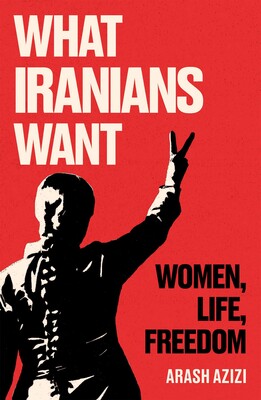What Iranians Want: Women, Life, Freedom
- By Arash Azizi
- Oneworld Publications
- 256 pp.
- Reviewed by Andrew M. Mayer
- April 4, 2024
A heartening glimpse at recent protests inside Iran.

Arash Azizi, living in London but born in Iran in 1988, has written in What Iranians Want a serious appraisal of Iran’s current politics and demonstrations from the standpoint of its most oppressed citizens: women. The author finds a unique angle to portray the struggle: via the notorious 2022 deaths of Mahsa Amini, 22, at the hands of the Iranian morality police (for wearing a loose hijab on the subway in Tehran), and of Sarina Esmailzadeh, 16, beaten to death by Iranian police during a protest march.
The success of this book (which was written before Hamas’ attack on Israel in October 2023) lies in its portrayal of the various elements of Iranian society — labor unions, writers, entertainers, students, academics, the Green Movement, etc. — united in their efforts against oppression at the hands of the mullahs, Islamic Council, and the infamous Revolutionary Guard.
It’s helpful for readers to have an understanding of Iran’s recent history, from the 1953 CIA-backed overthrow of Prime Minister Mohammad Mosaddegh and subsequent installation of pro-Western Shah Mohammad Reza Pahlavi, through the toppling of the shah in 1979 by the Islamic Revolution of Ayatollah Khomeini. This was followed, in 1979-80, by the 444-day Iran Hostage Crisis and, in 1980-88, by the infamous Iran-Iraq War.
For 50-plus years, Iran has been controlled by religious fundamentalists who, with the possible exception of 1997-2005’s Khatami regime, are anti-West, anti-women’s rights, and anti-LGBTQ rights, and who quickly crush any talk of reform or rapprochement with America.
For decades, the country — or, at least, its government — has grown increasingly hostile to the West despite the efforts of reformers to implement a more neutral stance. The regime seemed to collaborate with the Taliban when it was in power in Afghanistan, and it took a hardline approach after 2017 to Afghan refugees, expelling those who practiced the Baha’i or any other frowned-upon faith. If anything, Iran is today more anti-West — and particularly anti-Israel — than ever before, siding openly with Russia and, more recently, with Hamas and Hezbollah.
What is both inspirational and frustrating about the constant protests by workers, youth, intellectuals, artists, and others chronicled in What Iranians Want is the fact that the needle in Tehran never seems to move in the direction of progress. Instead, the regime continues its draconian embrace of intimidation, arrest, imprisonment, and murder.
Nonetheless, author Azizi believes (in the face of overwhelming evidence to the contrary) that the fight for expanded rights in Iran is not a futile one. He may be correct: In January 2024, two female journalists were released from prison even though they’d been sentenced to years-long terms for writing about women’s-rights protests and the killing of Amini. (Progress, however, may be a “two steps forward, one step back” prospect: Also in January, the sentence of imprisoned Nobel Peace Prize laureate Narges Mohammadi was extended by 15 months.)
Azizi suggests that once Iran’s current leadership is no longer in power, the possibility will exist for the expanding of human rights in general and women’s rights in particular. But looking at the current international situation — in which Iran is supplying weapons to Hamas; meddling in Syria; failing to renew international nuclear-control agreements; and actively supporting remnants of ISIS in Iraq — it’s hard to share his optimism. Still, he is to be commended for writing an accessible, detailed report of Iran’s internal policies and the history of protest in the country over the past half-century.
Andrew M. Mayer is professor emeritus of humanities and history at the College of Staten Island/CUNY.

